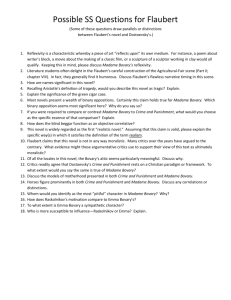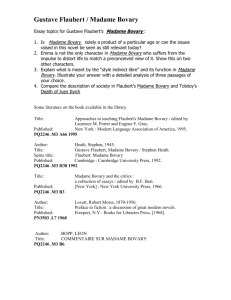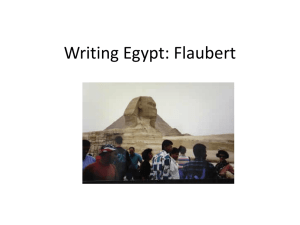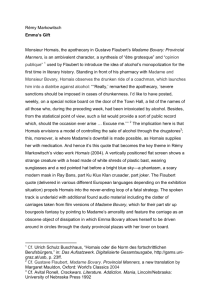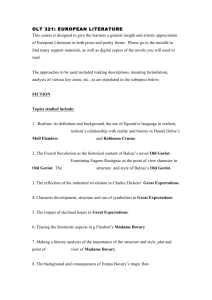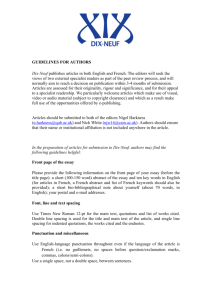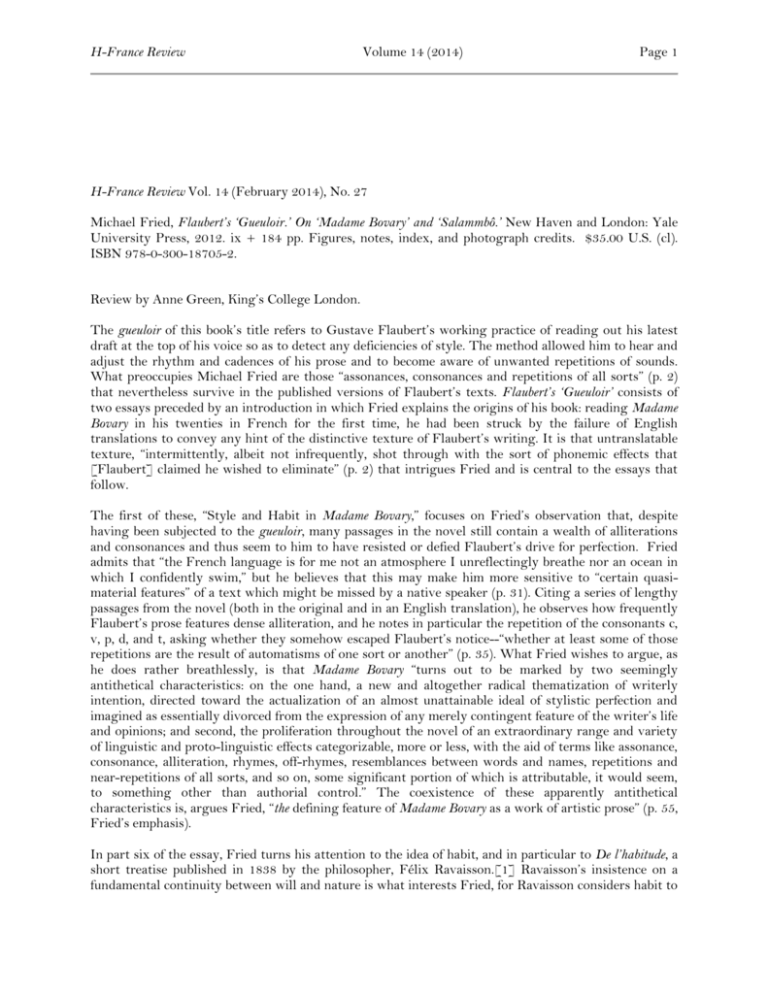
H-France Review
Volume 14 (2014)
Page 1
H-France Review Vol. 14 (February 2014), No. 27
Michael Fried, Flaubert’s ‘Gueuloir.’ On ‘Madame Bovary’ and ‘Salammbô.’ New Haven and London: Yale
University Press, 2012. ix + 184 pp. Figures, notes, index, and photograph credits. $35.00 U.S. (cl).
ISBN 978-0-300-18705-2.
Review by Anne Green, King’s College London.
The gueuloir of this book’s title refers to Gustave Flaubert’s working practice of reading out his latest
draft at the top of his voice so as to detect any deficiencies of style. The method allowed him to hear and
adjust the rhythm and cadences of his prose and to become aware of unwanted repetitions of sounds.
What preoccupies Michael Fried are those “assonances, consonances and repetitions of all sorts” (p. 2)
that nevertheless survive in the published versions of Flaubert’s texts. Flaubert’s ‘Gueuloir’ consists of
two essays preceded by an introduction in which Fried explains the origins of his book: reading Madame
Bovary in his twenties in French for the first time, he had been struck by the failure of English
translations to convey any hint of the distinctive texture of Flaubert’s writing. It is that untranslatable
texture, “intermittently, albeit not infrequently, shot through with the sort of phonemic effects that
[Flaubert] claimed he wished to eliminate” (p. 2) that intrigues Fried and is central to the essays that
follow.
The first of these, “Style and Habit in Madame Bovary,” focuses on Fried’s observation that, despite
having been subjected to the gueuloir, many passages in the novel still contain a wealth of alliterations
and consonances and thus seem to him to have resisted or defied Flaubert’s drive for perfection. Fried
admits that “the French language is for me not an atmosphere I unreflectingly breathe nor an ocean in
which I confidently swim,” but he believes that this may make him more sensitive to “certain quasimaterial features” of a text which might be missed by a native speaker (p. 31). Citing a series of lengthy
passages from the novel (both in the original and in an English translation), he observes how frequently
Flaubert’s prose features dense alliteration, and he notes in particular the repetition of the consonants c,
v, p, d, and t, asking whether they somehow escaped Flaubert’s notice--“whether at least some of those
repetitions are the result of automatisms of one sort or another” (p. 35). What Fried wishes to argue, as
he does rather breathlessly, is that Madame Bovary “turns out to be marked by two seemingly
antithetical characteristics: on the one hand, a new and altogether radical thematization of writerly
intention, directed toward the actualization of an almost unattainable ideal of stylistic perfection and
imagined as essentially divorced from the expression of any merely contingent feature of the writer’s life
and opinions; and second, the proliferation throughout the novel of an extraordinary range and variety
of linguistic and proto-linguistic effects categorizable, more or less, with the aid of terms like assonance,
consonance, alliteration, rhymes, off-rhymes, resemblances between words and names, repetitions and
near-repetitions of all sorts, and so on, some significant portion of which is attributable, it would seem,
to something other than authorial control.” The coexistence of these apparently antithetical
characteristics is, argues Fried, “the defining feature of Madame Bovary as a work of artistic prose” (p. 55,
Fried’s emphasis).
In part six of the essay, Fried turns his attention to the idea of habit, and in particular to De l’habitude, a
short treatise published in 1838 by the philosopher, Félix Ravaisson.[1] Ravaisson’s insistence on a
fundamental continuity between will and nature is what interests Fried, for Ravaisson considers habit to
H-France Review
Volume 14 (2014)
Page 2
be the dividing line between the two. “Habit is the dividing line, or the middle term, between will and
nature: but it is a moving middle term, a dividing line that is always moving, and which advances by an
imperceptible progress from one extremity to the other.[...] Consequently, habit can be considered as a
method--as the only real method--for the estimation, by a convergent infinite series, of the relation, real
in itself but incommensurable in the understanding, of Nature and Will.”[2] Although Fried admits
that there is no evidence that Flaubert ever read De l’habitude or even knew of its existence, its interest
for him lies in the fact that Ravaisson’s argument seems to correspond to his own perception of a
constant antithetical tension between automaticity and intention operating at a microlinguistic level in
the prose of Madame Bovary. This is not the first time that Fried has written about De l’habitude,
however; Ravaisson’s treatise informed his work on Courbet’s Realism [3] and part seven of “Style and
Habit in Madame Bovary” is devoted to a lengthy summary and extract from that book. What Fried sees
as Courbet’s predilection for pictorial structures “that evoke a continuity between absorptive states and
conditions” and his “tendency to thematize the mutual interpenetration of action and passivity” (p. 82),
are indicative, he argues, of a “profound affinity between Ravaisson’s metaphysics and Courbet’s art” (p.
80). While at pains to deny that he is suggesting that De l’habitude in any sense lies behind the
achievements of Flaubert or Courbet, Fried nevertheless claims that “something like a Ravaissonian
conception of habit, or say a Ravaissonian intuition of the continuity between will and nature as
mediated by habit, plays a role--different in the two cases--in Courbet’s Realist paintings [and in
Flaubert’s Madame Bovary]” (p. 84).
In the closing sections of the essay, Fried reviews related discussions of Flaubert by critics as diverse as
Charles Baudelaire, Charles Du Bos, Marcel Proust, Albert Thibaudet, and Jonathan Culler, before
ending with a coda on Emma Bovary’s funeral. Arguing that Flaubert could not have been unaware of
Courbet’s monumental painting of A Burial at Ornans (1849-1850), which was exhibited in Paris in
1850-1851 and again in 1855, Fried contends that “even a cursory glance at an illustration of the Burial
reveals how much it has in common with Flaubert’s description [of Emma’s cortège]” (p. 103). He
speculates that Flaubert would have realized that the funeral in Madame Bovary offered him the
opportunity to go beyond the realism of Courbet’s painterly achievement, and that A Burial at Ornans
may have spurred him to make a supreme effort when writing his own burial scene; thus by emphasising
sounds and smells and indicating the tiniest of movements with great linguistic delicacy he was able to
achieve effects that went beyond the power of painting.
In this volume’s second, shorter essay, “Willing Salammbô,” Fried turns to the novel that followed
Madame Bovary. With its setting in ancient Carthage and its roll-call of historical figures and alien
deities, Salammbô of course differs from its predecessor in the most obvious ways, but the difference that
interests Fried is a subtler stylistic one. Citing the novel’s opening paragraphs, he asserts that “one has
the sense (at any rate, I have the sense) of absolute authorial control, the impression, put more strongly
the conviction, that all the alliterations and consonances and repetitions, and beyond that the complex
phonic/visual phonemic pattern to which they give rise, have been intended as such by the writer” (p.
114). Fried’s central claim is that, in Salammbô, Flaubert was attempting to produce a work that would
be exclusively the product of conscious intention, devoid of the effects of automatism noted in Madame
Bovary, and that his chosen style was “one designed to foreground the action of authorial will at every
point” (p. 119). Flaubert’s use of unfamiliar, exotic words and names is taken as evidence of his wish “to
confront the reader with the sheer willfulness of the writing” (p. 122), just as the novel’s scenes of
gratuitous violence are seen as proof of Flaubert’s “determination to subject the reader to his will” (p.
140). Fried even suggests we can see elements of Flaubert himself in both Hamilcar, with his tactical
genius and impenetrable expression, and in the howling, wounded elephant “(Fureur de Baal/ Flaubert)”
(p. 141).
Although Fried’s main argument about the relationship between intention and habit is interesting, this
book has many puzzling aspects. The function of Flaubert’s gueuloir was not to screen out all repeated
sounds but merely to alert him to unwanted “mauvaise[s] assonance[s]” [4] and so the book’s original
H-France Review
Volume 14 (2014)
Page 3
premise that Madame Bovary’s phonic repetitions have somehow escaped Flaubert’s attention seems
dubious. And despite his focus on the central idea of habit, Fried does not try to explore Flaubert’s acute
awareness of the linguistic automatisms of his contemporaries, or his lifelong preoccupation with
received ideas, or his fiction’s frequent and varied thematization of the habitual.
In his introduction, Fried disarmingly admits that “the reader’s patience is likely to be stretched thin” (p.
4), but the intended readership of this book remains unclear. Flaubert specialists will already be familiar
with the views of major critics whose arguments are here summarised or quoted at great length, and
they are unlikely to need a definition of style indirect libre or the many pages of quotations from Madame
Bovary and Salammbô, complete with English translation. Moreover, their confidence in Fried’s
attention to detail will be undermined by the very large number of errors in the French transcriptions,
and by factual slips such as his assertion that Maupassant was Flaubert’s nephew (p. 52). Art historians
will already be familiar with Fried’s books on Courbet and Manet, whose arguments are extensively
repeated here, while non-specialists may be unwilling to persevere with the book’s mass of quotation
and its discursive prose. In proposing analogies between the works of Flaubert, Ravaisson, Courbet and
Manet, however, Fried does a service in pointing to hitherto unsuspected undercurrents of thought
linking these major nineteenth-century figures.
NOTES
[1] Félix Ravaisson, Of Habit, trans. and ed. Clare Carlisle and Mark Sinclair (London and New York:
Continuum, 2008).
[2] Ravaisson, Of Habit, p. 59.
[3] Michael Fried, Courbet’s Realism (Chicago and London, 1990).
[4] In a letter to George Sand on 10 March 1876, Flaubert wrote: “Quand je découvre une mauvaise
assonance...dans une de mes phrases, je suis sûr que je patauge dans le Faux.” Correspondance, ed. Jean
Bruneau and Yvan Leclerc (Paris: Gallimard, 2007), vol. V, p.26.
Anne Green
King’s College London
anne.green@kcl.ac.uk
Copyright © 2014 by the Society for French Historical Studies, all rights reserved. The Society for
French Historical Studies permits the electronic distribution of individual reviews for nonprofit
educational purposes, provided that full and accurate credit is given to the author, the date of
publication, and the location of the review on the H-France website. The Society for French Historical
Studies reserves the right to withdraw the license for edistribution/republication of individual reviews
at any time and for any specific case. Neither bulk redistribution/ republication in electronic form of
more than five percent of the contents of H-France Review nor re-publication of any amount in print
form will be permitted without permission. For any other proposed uses, contact the Editor-in-Chief of
H-France. The views posted on H-France Review are not necessarily the views of the Society for
French Historical Studies.
ISSN 1553-9172

